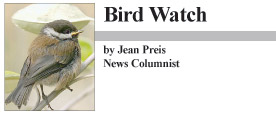Hawk Migration on Hacker’s Hill
 Hawk watching around here can sometimes be challenging. Often, hawks are glimpsed briefly as they zip through a clearing in the forest, or are so far overhead they look like specks in the sky.
Hawk watching around here can sometimes be challenging. Often, hawks are glimpsed briefly as they zip through a clearing in the forest, or are so far overhead they look like specks in the sky.
For many years, a friend and I hiked up Hawk Mountain in the fall to look for migrating hawks, and while we had memorable times sitting above the cliff admiring the view, chatting, and eating our lunch, that mountain never really lived up to its name. We were not terribly optimistic, then, when Loon Echo Land Trust announced it would hold a hawk watch on Hacker’s Hill, on Quaker Ridge Road in Casco, but they promised there would be birders who could help us identify hawks so we decided to go.
A stiff wind blew out of the southwest as we drove up Hacker’s Hill, and because any migrating hawks would have to fly into a headwind instead of having the advantage of a tailwind, our optimism about seeing birds dropped a notch. In the parking lot at the top of the hill, a few folks wearing binoculars milled around, but our eyes were on the sky, where two American kestrels, the smallest falcons, circled above us. The sun shone through their outspread rust colored tails as if they were stained glass, and any worries we might have had about the day vanished. We had brought folding chairs, but there was hardly time to set them up as another hawk flew overhead, and another, and another. All morning, we were on our feet, turning this way and that, looking at sharp-shinned hawks, broad-winged hawks, kestrels, ospreys, red-tailed hawks, turkey vultures, Cooper’s hawks and northern harriers. There were hawks we could not identify because they were too far away, but a young bald eagle glided low, right over our heads. Later, an adult bald eagle cruised around the edge of the hill, checking us out.
Occasionally, there was a lull in the action, which gave us a chance to take in the view of distant mountains, from Chocorua to Mount Washington, Old Speck, the top of Sugarloaf, Streaked Mountain, and every mountain in between. Below us the beautiful dark blue expanse of Sebago Lake shimmered in the sunlight. Up on the hill, people came and went during the day, drawn by curiosity about the hawk watch and eager to see birds. Those with more experience helped those who were newer to hawk watching. There were many interesting conversations, cut short whenever hawks appeared, but still we managed to enjoy the pizza, lemonade and cookies provided by Loon Echo.
We all made mistakes, as when we called out “sharp-shinned hawk!†only to have one of the expert hawk watchers point out that we were looking at a broad-wing who had narrowed its tail and pulled in its wings to counteract the stiff headwind. We learned that broad-wings are relatively small, chunky hawks, about the size of a crow, with distinctively bold black and white bands on the tail, and wings that look as if they have been outlined with a black marker pen. Dozens of broad-wings spiraled upward together in warm thermals, forming what are known as kettles because of the shape of the flock. These long distance migrants, who move through Maine from late August into October, were on their way to Central America and northern parts of South America.
Although privately owned, Hacker’s Hill has always been open to the public, and now Loon Echo Land Trust is raising funds to buy 27 acres there so all of us can continue to enjoy the place. In one day, 165 migrating hawks had been counted there, 115 of which were broad-winged hawks. An event that was intended to draw attention to the hill demonstrated that the place is one of Maine’s most significant, and easily accessible, hawk watching sites.
More information on Loon Echo Land Trust, and the Hacker’s Hill Campaign, can be found at www.loonecholandtrust.org or by calling 647-4352.

